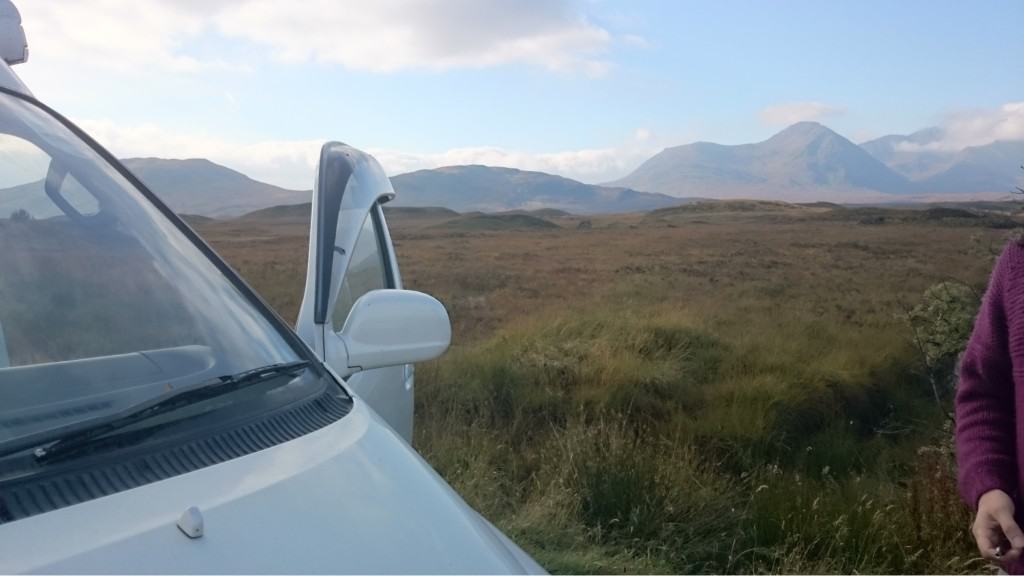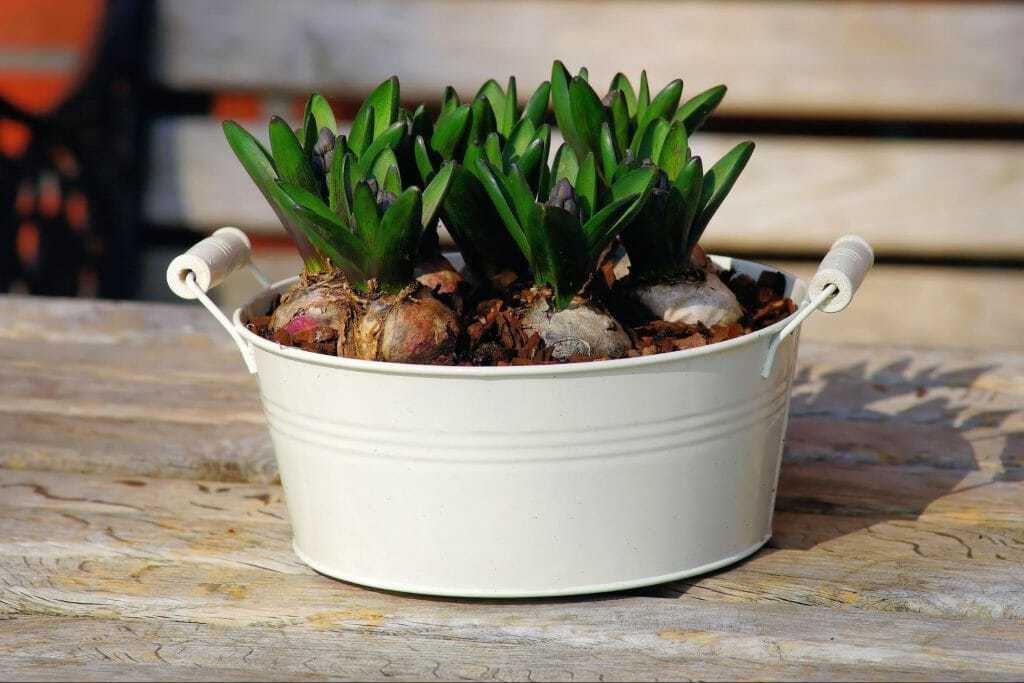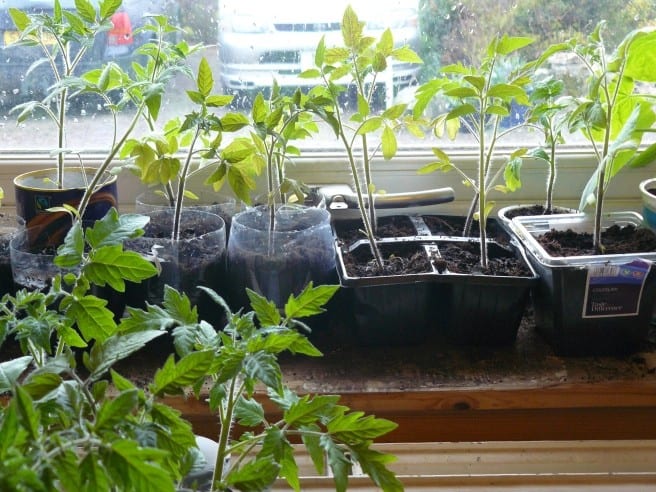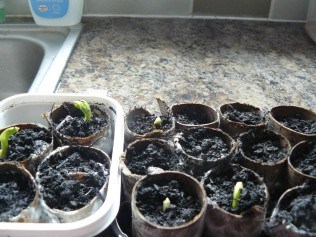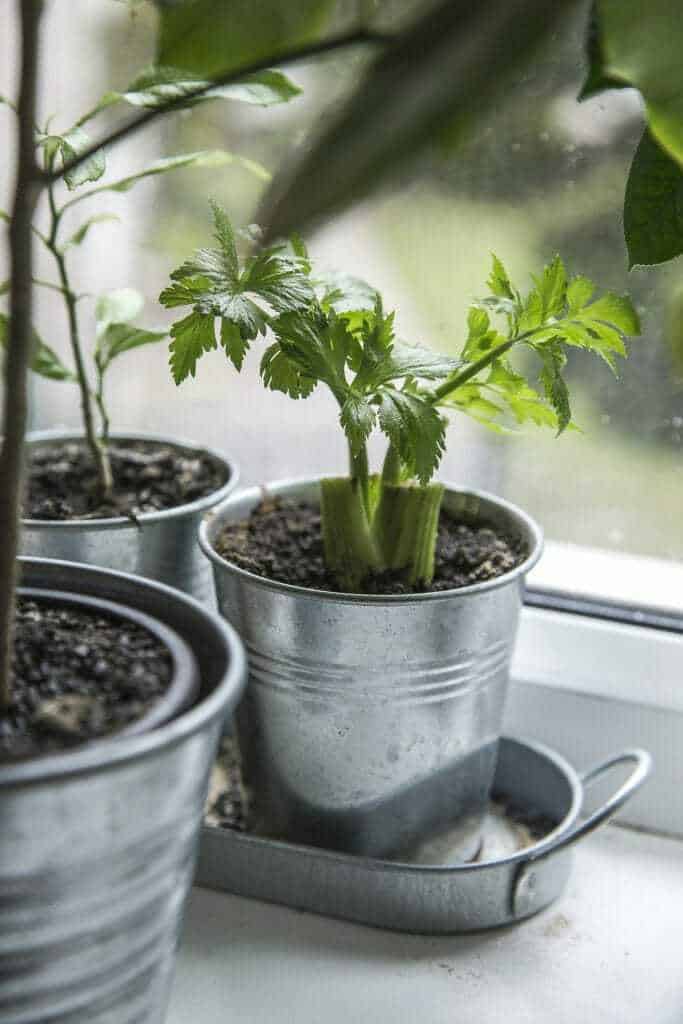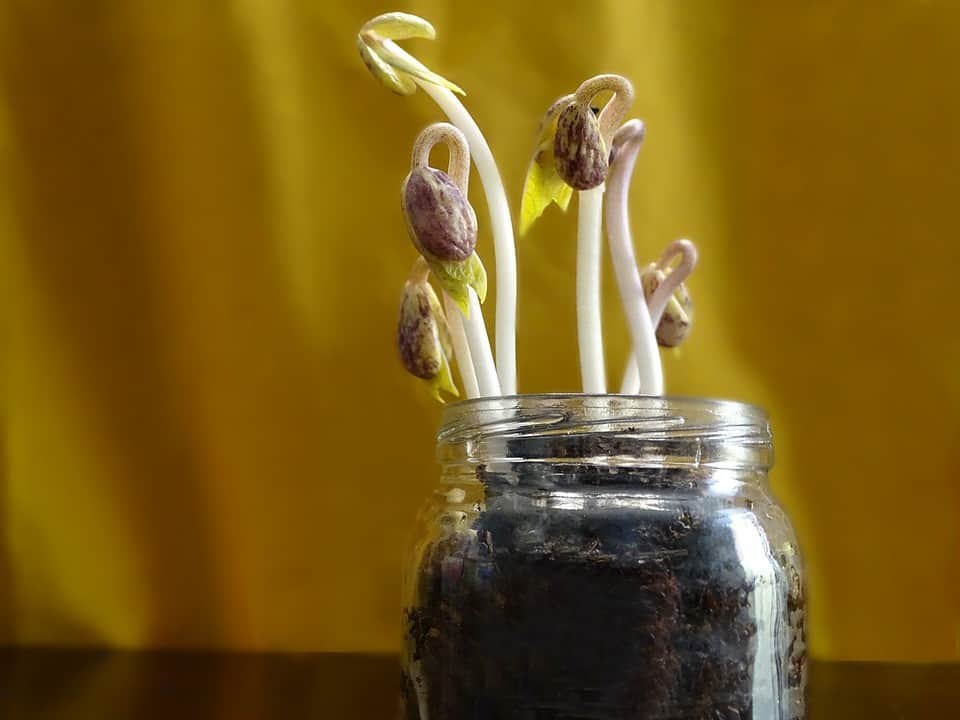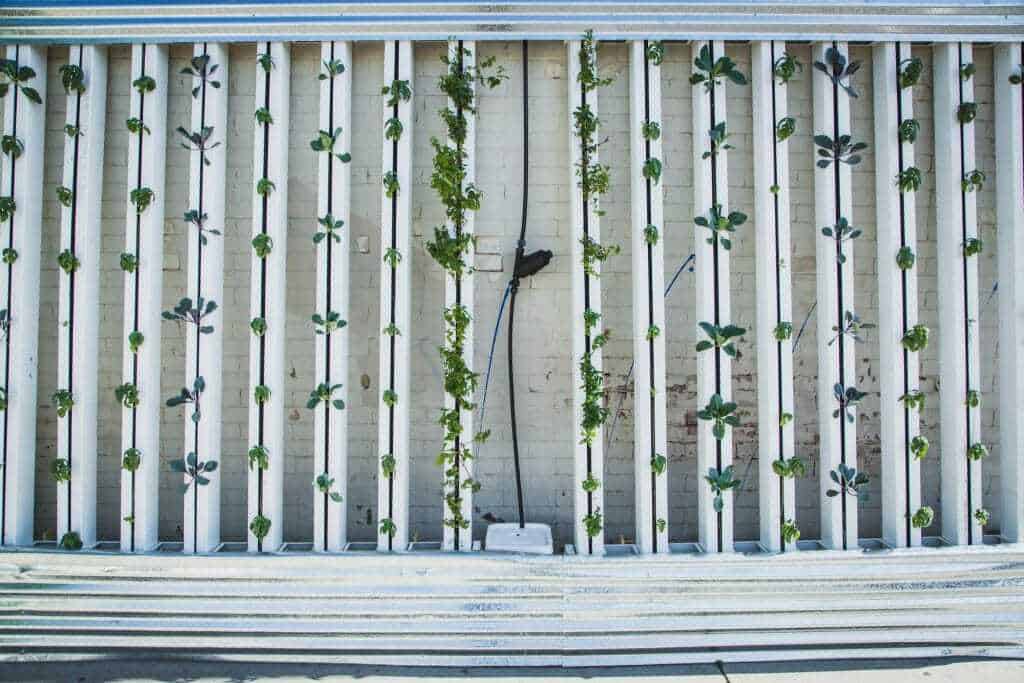Whether you live in an RV full time, or simply use one for your annual vacations, creating an RV container garden can be a great way to enhance your experience. As human beings, it is important for us to escape from the urban jungle and enjoy nature in all its infinite variety. Creating an RV container garden means that we can not only see the nature around us, but also take a little bit of it with us wherever we go.
Experiencing the wilds of Scotland on an RV adventure. Taking a break to see the scenery and wildlife on bleak but beautiful Rannoch Moor.
RV travel can be a wonderful way to experience the natural world, whether you travel from destination to destination, or stay in one beautiful spot. Whether you head for the ocean or the mountains, riversides, lakesides, forests, woodlands, moorland, meadows or desert, having an RV can be a great way to learn to appreciate our planet. But one of the best ways to learn about nature and natural cycles is to grow plants ourselves.
Why Create a Container Garden in or around your RV?
There are a number of reasons why creating an RV container garden is a good idea. You might, for example, grow plants in containers in order to:
- Produce some food for you and your travel companions.
- Do your part for pollinators and other beneficial insects around campgrounds.
- Enhance the air quality inside your RV with potted plants.
- Improve your mental health with green, living things.
- Enhance the RV living environment with aesthetically pleasing plants.
One small simple container with hyacinths that could be taken with you wherever you go.
(Note: Just make sure that you are aware of the laws and regulations regarding transporting plants over state lines, and be careful not to fall foul of these rules.)
Types of Container Garden
One of the first things to consider when thinking about creating an RV container garden is where you will be placing the containers in question. There are, broadly speaking, two different scenarios:
Extended Stay Container Gardens
The first scenario is an RV camper who will stay in one location for an extended period of time. If you are one of these campers, then you will have more choice when it comes to what type of container garden you choose. You will also be less restricted with regards to weight, and so will be able to grow more in larger containers that can be placed around your vehicle on the campground.
Portable, In-RV Container Gardens
The second scenario is one in which RV owners will travel around in their RV. Container gardens, in this instance, are located inside the RV. The containers in this instance are lightweight, easily secured for transit, and make the most of the space available inside the RV.
To an extent, the types and sizes of containers that you choose will be dictated by what you wish to grow. However, they will also be dictated by the circumstances of your travel, the size of your RV, and the situations in which you use it.
These tomatoes grown on a windowsill could also just as easily be grown on a shelf inside the RV that you can see outside.
What You Will Need To Create an RV Container Garden
In order to create your container garden in your RV, you will first need to decide which type of container garden you are going to create and which sorts of container you will require.
Sourcing Containers:
For an extended stay container garden, you can consider a wide range of traditional containers that could be used at home on your patio or elsewhere in your garden. Plastic pots are much cheaper and lighter to transport to your destination than terracotta or ceramic ones. However, plastic comes with a high environmental cost. For this reason, you may like to consider using reclaimed materials, or more environmentally-friendly materials instead.
Hessian Sacks or Grow Bags
One option is to choose to grow in hessian sacks or recycled/ eco-friendly grow bags. These are even lighter and much more easily transported to your destination than solid containers. Many plants will grow well in such containers – both edible and ornamental plants.
Though these may not look as attractive as other planters on the outside, there are ways to make them look more attractive on the campsite. For example, if you are staying on a campground for a long time, you could consider surrounding grow bags or sacks with natural materials that can be found in the surrounding area – such as rocks or logs. By placing such things around your planters, you can make them look lovely beside your RV. There is also the added benefit that such natural beautifiers can easily be returned to the surrounding environment at the end of your stay.
If you do wish to take larger containers with you to put outside at your destination, these can often be stored in the shower area for transportation.
Reusing Food Packaging & Waste Material as Planters:
For both extended stay RV container gardens, and portable, in-RV container gardens, you can also consider creating growing space without spending any money at all on containers. If you use your imagination, you will discover that there are plenty of ways to reuse the packaging that came around food that you have bought, and other household waste, to grow more food of your own, or ornamental plants to enhance your space.
For example:
Plastic Food Containers
You can pierce drainage holes in yogurt pots and tubs and the like and use these as pots to hold your seedlings Plastic trays often used in food packaging can be used beneath these to catch the water. Plastic containers with lids can often be used to make small, makeshift propagators which make it easier to grow seeds on the go.
Toilet Roll Tubes
Toilet roll tubes are fantastic containers for small seedlings that don’t like their roots to be disturbed. Peas, for example, can be grown for shoots, or planted into larger containers, complete with the toilet roll tube, when they have grown a little.
Broad beans sprouting in toilet roll tube planters.
Newspaper Cups
Another biodegradable seed planter that can be popped right into the ground with your seedlings are cups made of newspaper or other plain waste paper or card. Simply fold over the bottom to keep in your growing medium and they should hold together well enough to see you through to the time for planting out.
Tin Cans
Celery growing in metal pots. You could just as easily use tin cans for this purpose.
Tin cans can be another valuable resource for those looking to create a container garden inside their RV. Tin cans can be great planters for succulents and other ornamental house plants, but can also be used to hold small plastic pots in place. By screwing tin cans to a shelf in your RV, which can be made from any reclaimed timber, you can make safe housings for a few small seedlings or plants while in transit. You can also consider screwing or bolting tin cans directly to a cupboard door or wall panel in your RV. Rows of such cans can be used to create an area to grow a range of herbs or salad crops, for example.
Glass Jars
Glass jars can also be used as planters for small plants or seedlings. You can stop glass jars from falling over by placing them into holes cut into a small shelf or your countertop. You can also use suction cups to affix these or other DIY planters to a window.
If you do not like the look of the makeshift containers you have created, you can always paint them with an eco-friendly water-based paint to improve their appearance.
You can sow a wide range of seeds in jars to provide food or flowers for other, larger containers if you wish.
Sourcing Your Growing Medium
Once you have decided on your containers, you will also have to consider the growing medium in which your seeds and plants will grow. Most plants will require a fertile mix of soil and compost (or other organic material). The cheapest and easiest way to source the growing medium you need for your RV container garden is to create it yourself.
Making your own compost may not seem like something you can do when living in, or spending time travelling in, an RV. But it is possible to make your own compost even in the smallest of spaces.
Making Compost in an RV
In an RV, you are unlikely to be able to create a huge volume of compost, and it is certainly not an overnight solution. However, it will almost certainly be possible for you to create a small amount – enough for a small edible garden or a few attractive containers. Making your own compost in an RV is easier than you may imagine.It is a great way to reduce the waste you create and live greener.
Fruit and vegetable peelings, and other kitchen scraps, newspaper and cardboard, can be turned into compost – compost that could be used as a growing medium for your indoors plants. You don’t need a lot of space for a compost bin, and you can even compost indoors if you don’t have any outside space. Making your own compost is the very best way to put waste to good use.
There are several ways to compost indoors, and in small spaces. One of the best of these is called vermiculture. Vermiculture is the process of using worms to help you to create a good, fertile compost for your plants.
Vermiculture in an RV
The worms you need for a wormery are called ‘tiger worms’ and you can order them online in many parts of the world. These worms are especially good at the job of breaking down compost. They need air, food, water, and the right temperature – between around ten and twenty-five degrees Celsius is ideal. When you get all of those things right, you can pretty much leave them to get on with their job of making your compost, simply adding kitchen scraps and cardboard and paper in small amounts as you go along. In may feel a little odd to have some ‘stowaway’ worms on board your RV. But they can definitely be very helpful companions for your RV adventures.
A wormery can often be fitted into a cupboard on your RV, perhaps beneath kitchen surfaces, where it is easy to check on and to add kitchen waste to when necessary. The worms in your wormery will provide you with useable compost in a matter of months, and will also provide you with a liquid called ‘worm tea’ which is a valuable liquid plant feed that can help keep container plants happy and healthy.
Of course, wormeries will not provide you with compost overnight. While they are a wonderful longer-term, sustainable solution for your RV, you may well have to purchase some potting soil or compost to get you started with your container gardening in the first place.
Growing Plants With Water: Hydroponics in an RV
This hydroponics green wall shows how it is possible to grow plants in water vertically, to make the most of small spaces. A scaled down version could work in an RV.
Another option that you could consider as an alternative to growing plants in soil or compost is growing them with water. Growing plants with water – hydroponics – can be a fantastic solution for small spaces – including an RV.
Hydroponics is a gardening method whereby plants are grown not in soil, but in water. Plants that will usually grow in soil are grown with their roots in a nutrient-rich water solution. A number of different substrates are used to support the plant roots, including expanded clay aggregate, gravel, perlite, vermiculite or polystyrene.
There are a number of different hydroponic systems that could be of use in an RV. The simplest involve just a tub or tank, or even just a plastic bucket topped with a lid in which holes have been cut for each plant.
Another relatively easy hydroponic system to implement in an RV is a continuous flow solution culture. In these systems, nutrient water is set up to continuously flow past plant roots through a nutrient film in a root mat. This system can be used to create a vertical garden to grow a variety of leafy greens. Root matting can be placed in sections of old drainpipe, for example, and affixed to a wall or cupboard door inside your RV, and a low-energy pump can be used to allow water to flow through the system. This could be run from solar panels on the roof for a truly sustainable indoors gardening solution.
One of the great things about hydroponics systems is that they can be used in even the smallest of spaces. They can also use less water than traditional watering does.
Collecting Water and Watering Container Plants in Your RV
One you have sourced your containers, growing medium and other necessary items, and have sown your seeds or potted up your plants, there is still the question of maintaining these containers over time. Plants will, of course, need to be watered. How much will depend, of course, on which plants you have chosen to grow.
By affixing guttering to your RV, you can develop a system for harvesting rainwater when you stay in one place for any length of time. A rainwater harvesting system could feed back into your RV’s existing water supply tank, or be channelled into a barrel or butt to provide additional water stores. A rainwater filtration system for your RV could be a way to use rainwater not only for watering your plants but for all your freshwater needs.
Getting started with container gardening is a great way to become more sustainable and eco-friendly, whether you live or simply vacation in your RV. The above should help you get started with this worthwhile pursuit.

Elizabeth Waddington has an MA from St. Andrews University and a Permaculture Design Certificate. She is a green living consultant, with a passion for sustainable travel, permaculture and the natural world. She lives in rural Fife, just north of Edinburgh, close to the Firth of Forth on the east coast of Scotland.
No stranger to RV travel, Elizabeth has travelled all over Scotland, the UK and beyond in search of natural wonders in her RV. Her camping adventures have taken her to the Grand Canyon, up the Pacific Coast of the US, to Yellowstone National Park, the Grand Tetons and to explore the wonders of Utah. She has travelled extensively in the Pacific Northwest, and around New England. In Europe, she has taken trips through much of the western part of the continent, travelled up to Norway, and down through Romania and Bulgaria to Istanbul. She looks forward to further eco-friendly adventures.
